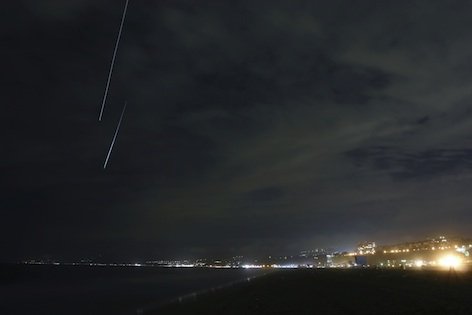Meteors are space rocks.
Small bits of meteors sometimes come to Earth.
When they do they get hot and glow.
We call them shooting stars.
Some land on Earth and then we call them meteorites.
A meteoroid streaking through space towards Earth is called a meteor. If it lands on Earth it is called a meteorite. ©Getty Images
Many names for a rock!
Flying around in space there are many rocks. The big ones are called asteroids. They bump into each other and break into smaller and smaller pieces. The smaller pieces are called meteoroids (say mee-tee-uh-royd).
Asteroids and meteoroids orbit the sun like the planets do.
Some of the smaller pieces sometimes fall to Earth. As a rock comes close to Earth, it is called a meteor. The meteor heats up and the air around it glows. Most of them burn up. Lots of meteors crash into Earth but most of them are the size of a speck of dust.
Have you ever heard of a shooting star, or falling star? Perhaps you have seen one: a quick flash of light streaking in the dark. Well, they aren’t really stars at all, they are meteors. When many meteors are seen in a short time in the same part of the sky, it is called a meteor shower.
Image below of a meteor shower is a Jupiter Image
If a meteor lands on Earth without burning up, it is called a meteorite (say mee-tee-aw-rite). Most are like dust or pebbles, some are big rocks and a few are very big.
A meteorite. Image©Getty
Some facts about meteors
Millions of meteors enter Earth’s atmosphere every day. A meteor can be as small as a speck of dust. About 500 meteorites reach the Earth’s surface every year. Scientists study them and learn a lot about our solar system.
Some meteorites are stone and some are iron.
The fastest meteoroids travel through space at about 42 kms per second.
Very, very rarely a really huge meteorite has hit the Earth and has made a big hole called a crater.
Meteor crater in Arizona, USA. Photo©kidcyber
About 50,000 years ago a huge meteorite hit the ground in Arizona, USA. Today people visit the huge crater, called the Barringer Crater. A museum has been built on one part of the rim, with much information about the impact. NASA used the middle of the crater as a place where astronauts were trained before going into space. You can see the training buildings in the centre, which gives you an idea of the size of the crater.
It’s a good idea to get information from more than one source!
Watch a video of how a meteor travels to Earth
https://www.youtube.com/watch?v=HBFfBz0n_SE





